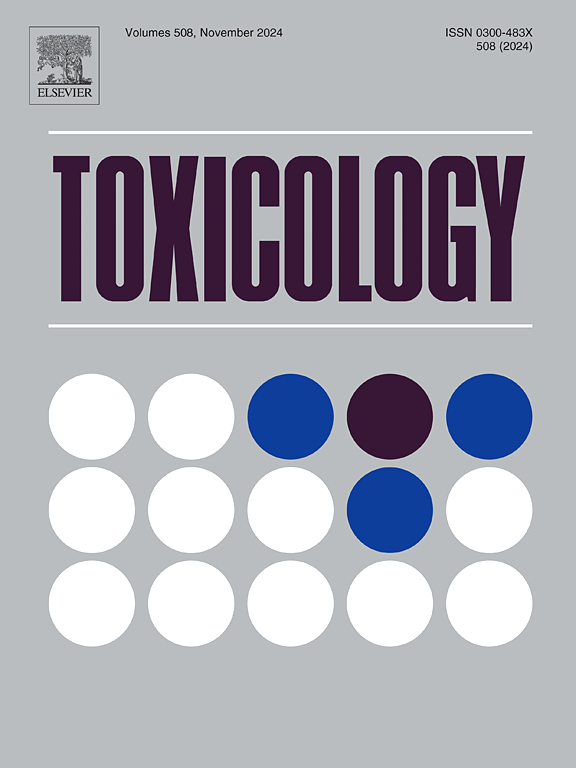Bisphenol A disrupts the neuronal F-actin cytoskeleton by activating the RhoA/ROCK/LIMK pathway in Neuro-2a cells
IF 4.8
3区 医学
Q1 PHARMACOLOGY & PHARMACY
引用次数: 0
Abstract
Bisphenol A (BPA) is an environmental endocrine disruptor that is widely present in the environment and has been reported to affect neuronal cytoskeleton and neural function. However, the exact molecular mechanisms remain unclear. In the present study, the effects of BPA on cytoskeleton rearrangement were examined, and the associated signaling pathways, which were influenced by the RhoA/ROCK/LIMK pathway in Neuro-2a cells in vitro, were identified. Specifically, Neuro-2a cells were exposed to BPA, and the effects of BPA exposure on the cytoskeleton of neuronal cells and on the activation or nonactivation of the RhoA/ROCK signaling pathway were evaluated using Cell Counting Kit-8 (CCK8), phalloidin staining, western blot, and real-time PCR. A RhoA inhibitor (Rhosin hydrochloride) and a ROCK inhibitor (Y-27632) were then used to elucidate the precise function of the pathway. The results demonstrated that 50–100 μM BPA exposure inhibited Neuro-2a cell viability and caused the formation of aberrantly polymerized F-actin and stress fibers. In addition, the RhoA/ROCK pathway was activated, and the expression levels of the pathway-related molecules—RhoA, ROCK2, LIMK1, Cofilin, Profilin, p-MLC2, and F-actin were dramatically elevated. The addition of Rhosin and Y-27632 resulted in a decrease in F-actin polymerization in the Neuro-2a cells, the disassembly of stress fibers, and a noteworthy drop in the levels of molecular proteins related to the RhoA/ROCK pathway affected by BPA. Together, these new findings indicated that BPA exposure thus activated the RhoA/ROCK signaling pathway and caused an abnormal accumulation of F-actin in the Neuro-2a cells, in turn altering the microfilament cytoskeleton. F-actin was restored when the RhoA/ROCK pathway was inhibited, suggesting that the process of BPA-induced neuronal cytoskeletal degradation is linked to the RhoA/ROCK signaling cascade.
双酚 A 通过激活神经-2a 细胞中的 RhoA/ROCK/LIMK 通路,破坏神经元的 F-肌动蛋白细胞骨架。
双酚 A(BPA)是一种环境内分泌干扰物,广泛存在于环境中,据报道会影响神经细胞骨架和神经功能。然而,其确切的分子机制仍不清楚。本研究考察了双酚 A 对细胞骨架重排的影响,并确定了体外神经-2a 细胞中受 RhoA/ROCK/LIMK 通路影响的相关信号通路。具体来说,研究人员将神经-2a细胞暴露于双酚A,并使用细胞计数试剂盒-8(CCK8)、类磷脂染色、Western印迹和实时聚合酶链式反应(real-time PCR)评估了双酚A暴露对神经细胞细胞骨架和RhoA/ROCK信号通路激活或未激活的影响。然后使用 RhoA 抑制剂(盐酸 Rhosin)和 ROCK 抑制剂(Y-27632)来阐明该通路的确切功能。结果表明,暴露于 50-100μM BPA 会抑制 Neuro-2a 细胞的活力,并导致 F-actin 和应力纤维的异常聚合。此外,RhoA/ROCK 通路被激活,通路相关分子-RhoA、ROCK2、LIMK1、Cofilin、Profilin、p-MLC2 和 F-actin 的表达水平显著升高。加入 Rhosin 和 Y-27632 后,Neuro-2a 细胞中的 F-肌动蛋白聚合减少,应力纤维解体,与受双酚 A 影响的 RhoA/ROCK 通路相关的分子蛋白水平显著下降。这些新发现共同表明,暴露于双酚 A 会激活 RhoA/ROCK 信号通路,导致神经-2a 细胞中的 F-肌动蛋白异常积聚,进而改变微丝细胞骨架。抑制RhoA/ROCK通路后,F-肌动蛋白得以恢复,这表明双酚A诱导的神经元细胞骨架降解过程与RhoA/ROCK信号级联有关。
本文章由计算机程序翻译,如有差异,请以英文原文为准。
求助全文
约1分钟内获得全文
求助全文
来源期刊

Toxicology
医学-毒理学
CiteScore
7.80
自引率
4.40%
发文量
222
审稿时长
23 days
期刊介绍:
Toxicology is an international, peer-reviewed journal that publishes only the highest quality original scientific research and critical reviews describing hypothesis-based investigations into mechanisms of toxicity associated with exposures to xenobiotic chemicals, particularly as it relates to human health. In this respect "mechanisms" is defined on both the macro (e.g. physiological, biological, kinetic, species, sex, etc.) and molecular (genomic, transcriptomic, metabolic, etc.) scale. Emphasis is placed on findings that identify novel hazards and that can be extrapolated to exposures and mechanisms that are relevant to estimating human risk. Toxicology also publishes brief communications, personal commentaries and opinion articles, as well as concise expert reviews on contemporary topics. All research and review articles published in Toxicology are subject to rigorous peer review. Authors are asked to contact the Editor-in-Chief prior to submitting review articles or commentaries for consideration for publication in Toxicology.
文献相关原料
公司名称
产品信息
索莱宝
DMSO
 求助内容:
求助内容: 应助结果提醒方式:
应助结果提醒方式:


